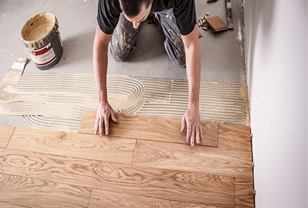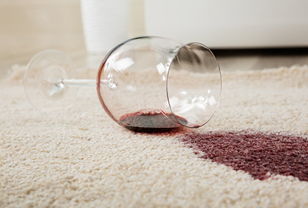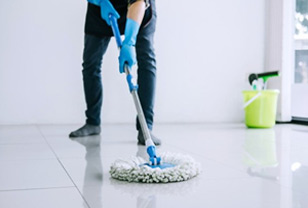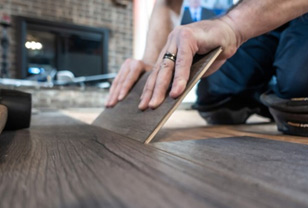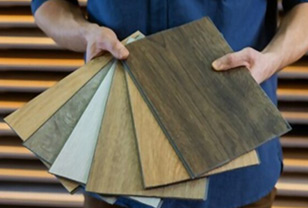How to Clean Vomit From Carpet: Guide for a Fresh and Clean Home
But don't worry. We're here to help you through this challenging task.
In this guide, we'll walk you through the entire process of how to clean vomit from carpet, step by step, so you can confidently tackle the mess and restore your carpet to its clean and fresh state.
Cleaning Vomit in General
When it comes to cleaning vomit from carpets, it's all about taking swift and thorough action. The cleaning process involves a series of steps that, when followed carefully, will leave your carpet looking and smelling fresh.
Remove the Vomit
First things first, you'll need to remove as much of the vomit as possible. By promptly addressing the mess, you'll prevent it from soaking deeper into the carpet fibers and causing a more stubborn stain.
This step lays the groundwork for the rest of the cleaning process and ensures that you're starting off on the right foot.
Drying Things Out
Once the majority of the vomit has been removed, it's time to focus on extracting any lingering moisture.
Drying the area is crucial because it helps prevent the growth of mold and mildew, which can lead to unpleasant odors and even health issues. This step sets the stage for a more effective stain-removal process.
Remove the Stain
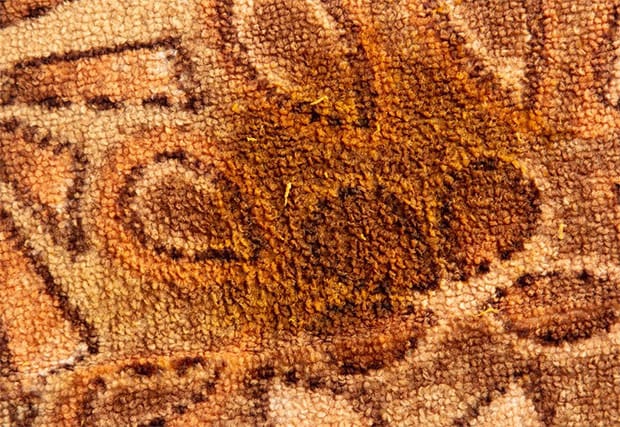
Prevent stains by acting as promptly as possible
With the excess moisture taken care of, you can now concentrate on removing the stain itself.
This step is all about restoring the carpet's appearance and ensuring that no trace of the unfortunate incident remains. It's important to choose the right cleaning solution and technique for your carpet type to get the best results.
Different carpet materials may require different cleaning solutions. Consider the carpet's fabric and color before selecting a cleaner to ensure the best results.
Here are some common options for carpet stain removal:
- Dish soap: A mild dish soap mixed with water can also be effective at removing stains. It's a gentle option, suitable for carpets that might be sensitive to harsh chemicals.
- Vinegar solution: A mixture of equal parts water and white vinegar can be used to treat stains. This natural solution is safe for most carpet types and can be particularly effective at removing acidic stains.
- Carpet cleaner: Commercial carpet cleaners are designed specifically for removing stains from carpets. They often come in spray or foam forms and are safe for most carpet types. Check the label to ensure compatibility with your carpet.
Avoid using bleach or ammonia-based cleaners, as they can damage carpet fibers and cause discoloration.
Eliminate the Odor
After tackling the stain, you'll want to focus on eliminating any lingering odors. Vomit can leave behind an unpleasant smell, and it's essential to neutralize it to maintain a fresh and welcoming atmosphere in your home. This step will have your space smelling clean and inviting in no time.
Here are some effective deodorizing options:
- Baking soda: Baking soda is a natural deodorizer that can help neutralize unpleasant odors. Sprinkle it over the cleaned area, let it sit for a few hours, and then vacuum it up.
- Vinegar solution: If you clean the stain with vinegar, it can also help neutralize the odor. Simply allow the area to air-dry after treating the stain.
- Carpet deodorizer: Commercial carpet deodorizers are available in various fragrances and can be effective at neutralizing odors. Follow the manufacturer's instructions for the best results.
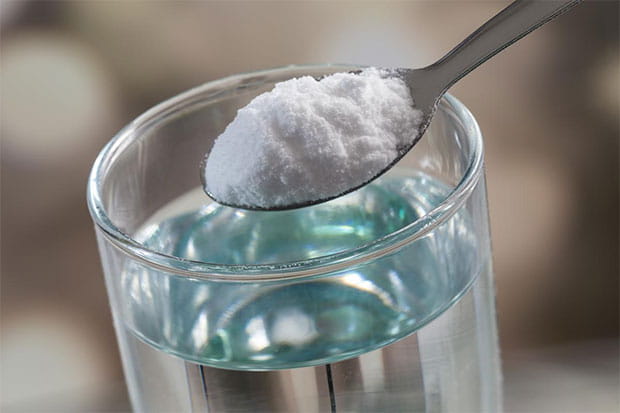
Using baking soda is a good idea for treating vomit odor
The Finishing Touches
Finally, it's time to give your carpet some post-cleaning care. This involves ensuring that the cleaned area dries properly, as well as fluffing the carpet fibers to restore their original texture.
These finishing touches will have your carpet looking as good as new, so you can put the whole ordeal behind you.
You can consider the following methods:
- Carpet fresheners can add a pleasant fragrance to your carpet, giving it a new and clean feel. These products are available in various fragrances and forms, such as powders or sprays.
- Carpet protectants help shield your carpet fibers from stains and spills, making it easier to clean up future messes. This treatment can be particularly useful in high-traffic areas or for those with pets and children.
- Carpet raking is a process that involves using a specialized carpet rake or grooming brush to lift and separate carpet fibers. This can help restore the carpet's appearance and remove any matting caused by cleaning or foot traffic.
Use it before applying any protectants or fresheners. It's especially helpful for carpets with a high pile or those that tend to mat easily.
What You'll Need
Having these supplies on hand will ensure a smooth and efficient cleaning process:
- Gloves: to protect your hands from germs and bacteria.
- Cardboard, plastic bag, or spatula: for removing solid debris.
- Paper towels or clean, dry cloths: for blotting excess moisture.
- Baking soda: to absorb moisture and neutralize odors.
- Soft-bristled brush (optional): for gently agitating the carpet fibers during cleaning.
- Vacuum cleaner: to remove baking soda and any remaining debris.
- Carpet cleaner or homemade cleaning solution (vinegar, dish soap, or diluted hydrogen peroxide): for treating the stain.
- Spray bottle or clean cloth: for applying the cleaning solution.
- Enzymatic cleaner (optional): for tackling stubborn odors.
- Fan or dehumidifier (optional): for speeding up the drying process.
How to Clean Vomit From Carpet
Remove the Vomit
Put on Gloves
Before diving into the cleaning process, it's essential to gear up properly:
Put on a pair of disposable gloves, such as latex or nitrile gloves, to protect your hands from germs and bacteria present in the vomit. Wearing gloves also ensures that you don't inadvertently transfer the mess to other surfaces while cleaning.
If you have a sensitive nose, consider using a disposable face mask to minimize any discomfort from the odor.
Scoop and Remove Solids
Begin by removing the bulk of the vomit from the carpet. You can use a spatula, a piece of stiff cardboard, or a plastic bag turned inside out. Each option has its unique method:
- Cardboard: Find a sturdy piece of cardboard and carefully cut it into a scoop-like shape with one straight edge. Gently slide the straight edge underneath the vomit, lifting it off the carpet without pressing down or spreading it further.
- Plastic bag: Turn the plastic bag inside out, place your hand inside, and use it as a glove to pick up the vomit. Gently gather the solids without pushing them deeper into the carpet fibers. Once you've collected the vomit, turn the bag right side out to enclose the mess.
- Spatula: If you opt for a spatula, make sure it's clean and has a flat edge. Gently slide the flat edge under the vomit, scooping it up and lifting it off the carpet without pressing down or spreading it further.
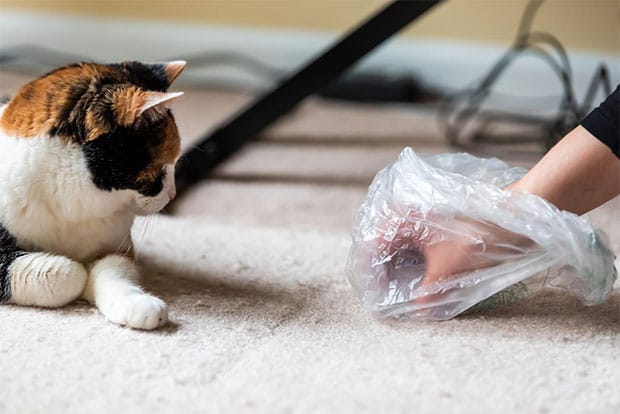
There are many choices for removing the vomit
The goal with any of these methods is to remove as much of the substance as possible to make the subsequent cleaning steps more manageable.
To avoid spreading the mess while removing solids, slide a piece of cardboard or a spatula under the vomit at an angle, lifting it up and into a plastic bag. This technique can help minimize contact with the carpet and ensure a smoother cleanup.
Blot the Liquids
After you've scooped up the solids, it's time to address any remaining liquids:
- Grab a pile of paper towels, a clean cloth, or an old towel, and gently blot the affected area.
- Start from the outside of the stain and work your way inwards to prevent spreading the liquid.
- Apply gentle pressure to soak up as much moisture as possible, but avoid rubbing or scrubbing, which could cause the stain to penetrate deeper into the carpet fibers.
- Replace the paper towels or cloth as needed until you've removed most of the liquid.
Absorb Excess Moisture
To further extract moisture and facilitate the drying process, you can use baking soda or cornstarch. These materials help draw out any remaining moisture and minimize the risk of mold and mildew growth.
- Cover the affected area: Generously sprinkle the chosen absorbent material over the stained area. Ensure that you cover the entire spot and even extend a bit beyond its perimeter to account for any moisture that may have spread.
- Let it sit: Allow the absorbent material to work its magic for about 15-20 minutes. During this time, it will help draw out any remaining moisture and minimize the risk of mold and mildew growth.
- Vacuum the area: After the waiting period, use a vacuum cleaner to remove the powder. Be cautious not to press down too hard while vacuuming, as you might risk pushing the moisture back into the carpet fibers.
If the vomit was particularly wet or the stain appears deep, you may need to repeat the process with the absorbent material. Also, ensure that the vacuum cleaner is set to the appropriate height for your carpet type to avoid damaging the fibers.
When using baking soda to absorb excess moisture, ensure that the entire area is covered with a generous layer. However, don't overdo it, as using too much can make the vacuuming process more difficult.
Be cautious when vacuuming baking soda, as sucking up large amounts can clog your vacuum or damage its filters. Empty the vacuum cleaner's bag or canister more frequently to avoid issues.
Remove the Stain

Apply the stain removal solution on the affected area
Regardless of the cleaning solution you choose, follow these steps to effectively remove the stain:
- Test the stability of the color: Before applying the cleaner to the entire stain, test a small, inconspicuous area of your carpet to ensure it won't cause any discoloration or damage.
- Apply the cleaning solution: Gently apply your chosen cleaning solution to the stained area, covering it completely. Avoid soaking the carpet, as excessive moisture can be difficult to remove and may lead to mold and mildew growth.
- Let it sit: Allow the cleaning solution to sit on the stain for a few minutes, giving it time to break down and then lift the stain.
- Blot the area: Using a clean cloth or paper towel, gently blot the treated area to lift the stain. Start from the outside and work your way inwards to prevent spreading the stain.
- Rinse and blot: If necessary, rinse the area with clean water to remove any residue from the cleaning solution. Then, blot the area again to remove excess moisture.
Always work from the outside towards the center to prevent spreading the stain further. Some stains may require to repeat the process. If the stain persists, repeat until it is removed.
Eliminate the Odor
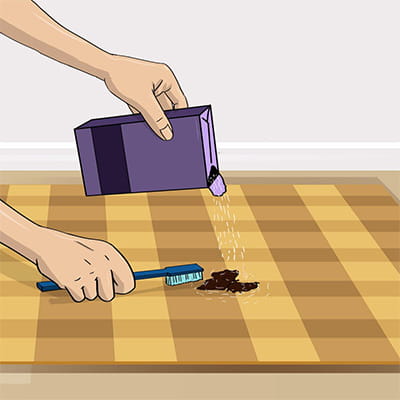
Sprinkle baking soda over the cleaned area
Follow these steps to get rid of any offending smells emitting from the vomit:
- Apply the deodorizer: Sprinkle or spray the chosen deodorizer over the cleaned area, ensuring that you cover the entire spot.
- Let it sit: Allow the deodorizer to work its magic for the recommended amount of time. Baking soda typically requires a night, while commercial deodorizers may have specific instructions on the label.
- Vacuum the area: Once the deodorizer has had time to neutralize the odor, vacuum up any residue, being cautious not to press down too hard and risk damaging the carpet fibers.
With commercial deodorizers, always read the label to ensure they're compatible with your carpet type.
If the odor persists after the initial treatment, you may need to repeat the process to completely eliminate it. In extreme cases, consider consulting a professional carpet cleaner for assistance.
Post-Cleaning Treatment (Optional)
Carpet Freshener
Follow the manufacturer's instructions, which usually involve sprinkling or spraying the freshener on the carpet and then allowing it to sit for a specified period before vacuuming up any residue.
Always check the label to ensure the freshener is suitable for your carpet type. Avoid using excessive amounts, as it may be challenging to remove the residue and can leave your carpet feeling sticky or stiff.
Carpet Protectant
Spray the carpet protectant evenly over the entire carpet or targeted areas, following the manufacturer's instructions. Allow it to dry thoroughly before walking on the carpet or placing the furniture back.
Make sure the carpet protectant is suitable for your specific carpet type. Avoid over-saturating the carpet, as this may cause the protectant to be less effective or leave a residue.
Raking
Gently rake the carpet in the direction of the carpet pile, using a back-and-forth motion. Work in small sections, lifting and separating the fibers as you go.
Be gentle when raking your carpet to avoid damaging the fibers. If you're unsure whether carpet raking is suitable for your carpet type, consult the manufacturer's guidelines or seek professional advice.
Tips on Vomit Removal
Cleaning up vomit from carpets can be a daunting task, but with the right methods, you can make the process more manageable and effective.
Here are some helpful tips and warnings to consider throughout the various stages of carpet cleaning:
- If you're using a commercial carpet cleaner, be sure to follow the manufacturer's recommendations for dwell time (how long the product should sit on the stain) to achieve the best results.
- When applying a cleaning solution or deodorizer, avoid using too much product, as it can be challenging to remove and may leave a residue on the carpet.
- Before applying any carpet protectant or freshener, ensure that your carpet is completely dry to avoid trapping moisture, which can lead to mold and mildew growth.
- If you're unsure about using a specific product on your carpet, perform a patch test in an inconspicuous area to ensure it won't cause any adverse reactions or discoloration.
- Remember to ventilate the room during the cleaning process. Open windows or use fans to help air circulate and speed up the drying process. This will also assist in reducing any lingering odors.
- Avoid walking on the carpet or placing the furniture back until it is entirely dry. If the carpet remains damp for an extended period, consider contacting a professional carpet cleaner for assistance.
- After raking your carpet, inspect the fibers for any signs of damage or fraying. If you notice any issues, stop raking and consult a professional for guidance.
- And as always, follow the manufacturer's recommendations for maintaining and cleaning your specific carpet type to ensure the best results and avoid any potential damage.
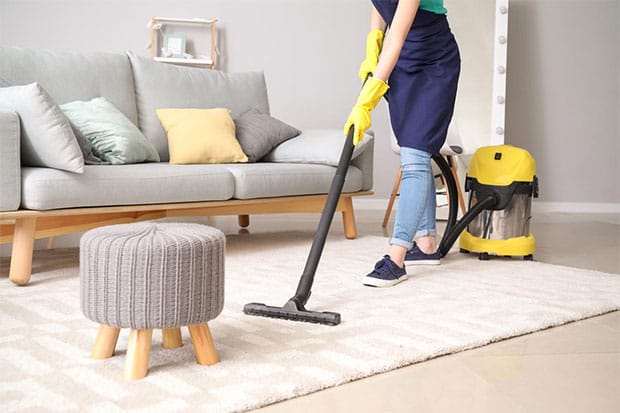
Vacuum the area afterwards for the best results
Summary
Cleaning vomit from your carpet may seem daunting, but with our comprehensive guide on how to clean vomit from carpet, you'll be well-equipped to handle the task.
By following the steps we've outlined and using the tips and tricks we've provided, you can effectively remove vomit stains and odors, leaving your carpet looking and smelling fresh. You can also check other guides on how to clean a carpet from us.
Remember, patience and persistence are key to achieving the best results, and with the right approach, you can tackle this challenge with confidence.
FREQUENTLY ASKED QUESTIONS
- 01. How to Get Throw Up Out of Carpet??
-
To get throw up out of your carpet, follow these steps: remove the solid matter, blot and dry the excess moisture, treat the stain with a carpet cleaner or homemade solution, and address any lingering odors.
Remember to always start with the least aggressive cleaning methods and work your way up if necessary.
- 02. How to Clean Dog Vomit From Carpet??
-
Cleaning dog vomit from your carpet follows a similar process to cleaning human vomit.
First, remove the solid matter, then blot the excess moisture. Treat the stain with a suitable cleaner (such as a pet-safe carpet cleaner or a DIY solution like vinegar and water), and address any lingering odors with baking soda.
- 03. How to Clean Vomit Smell From Carpet??
-
Start by sprinkling baking soda over the affected area, then let it there for a few hours or overnight to absorb the odor. Finally, vacuum the baking soda thoroughly.
- 04. Can I Use Hydrogen Peroxide to Clean Vomit From My Carpet??
-
Hydrogen peroxide can be an effective cleaning agent for vomit stains thanks to its stain-removing and disinfecting properties.
However, before using hydrogen peroxide, test it on an inconspicuous area of your carpet since it may cause discoloration or damage.
- 05. What Should I Avoid When Cleaning Vomit From Carpets??
-
When cleaning vomit from carpets, avoid scrubbing the stain, as it can push the vomit deeper into the carpet fibers and make it more difficult to remove.
Do not use hot water because it may set the stain permanently. Also, avoid using excessive amounts of cleaning products, as they can leave residues and damage your carpet.


